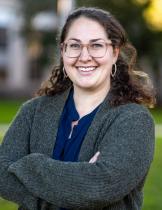
Evidence shows that intergenerational poverty requires multifaceted solutions

The National Academies of Sciences, Engineering, and Medicine recently issued a report on the drivers of and solutions to intergenerational poverty in the United States—defined as when a child growing up in poverty also experiences poverty as an adult. J-PAL North America staff had a conversation with J-PAL affiliated professor Greg Duncan (UC Irvine), chair of the authoring committee, to explore some of the report’s key takeaways, particularly that intergenerational poverty is a multifaceted challenge requiring multifaceted solutions. The views expressed by Greg are his own and do not necessarily represent those of the National Academies of Sciences, Engineering, and Medicine.
To start, can you tell us a bit about how this report came to be? What were the factors that motivated it?
The report was commissioned in 2021 by the US Congress, who was concerned about the impacts of intergenerational poverty on the families experiencing it and on the nation as a whole. They directed the National Academies of Sciences, Engineering, and Medicine to conduct a study on the drivers of and solutions to intergenerational poverty. This was a follow-up to the 2019 National Academies report on reducing child poverty; the new report was focused on the longer term, intergenerational impacts of policies and programs directed at children and their families. For both reports, I served as chair of an interdisciplinary committee that responded to the Congressional requests.
The report is incredibly comprehensive! How did you decide what to include?
We began by identifying all of the broad areas in which research had shown correlations between certain constructs and intergenerational outcomes for children. The list we developed encompasses seven broad domains: education, health, income and work, family structure, housing and neighborhoods, the criminal justice system, and the child welfare system. We were also directed to apply a racial and ethnic lens to our literature reviews. Portions of our report evaluate whether the research in each domain supports claims that certain constructs exert a causal impact on intergenerational poverty, which we define as instances in which a child growing up in a low-income household also experiences poverty in adulthood.
How did you identify policies and programs within the seven domains that had been shown to reduce intergenerational poverty?
First, we developed a “standard of evidence,” which was, in itself, an interesting challenge. We decided to focus on long-term studies that were either randomized evaluations or quasi-experimental designs that could make a compelling case for causal impacts on adult poverty, earnings, health, and criminal activity. We called these “direct-evidence” studies. Then we considered whether and how to include program and policy studies with strong evidence of impacts on short-term outcomes (e.g., test scores, birthweight) but not intergenerational outcomes. We called these “indirect-evidence” studies and included but did not feature them in the report. Finally, we focused on evidence published after 1990 because of changes in the US social safety net and other contextual conditions experienced by children in the control groups. For example, a control group in the 1960s would not have had access to the same supports (e.g., SNAP or Medicaid) that exist today, making it difficult to generalize the findings of older studies to today’s context.
The report identifies about two dozen effective programs and policies across seven domains that are driving intergenerational poverty. At the same time, you caution that not all programs and policies can be neatly grouped into a single domain. Can you elaborate on why this is and why it is important to note?
First, some interventions have generated impacts in more than one domain. Examples include lead-abatement policies, which quasi-experimental studies have indicated improve child health and cognitive functioning as well as to reduce crime, and a randomized evaluation of a cognitive behavioral therapy program called Becoming a Man (BAM), which found positive effects on both arrests and graduation rates.
Second, we wanted to think about synergies across programs—combinations of programs in different domains. For example, what combination of programs might best support employment and child development among low-income families with young children? These combinations are woefully under-researched and we wanted to call attention to that.
While we were unable to identify a single policy that would eliminate intergenerational poverty on its own, we did find examples of effective policies and programs in most of the seven domains. Policymakers might consider combining some of them in order to generate substantial reductions in intergenerational poverty.
In taking a racial disparities lens in this report, we found relatively few studies of policy impacts on specific racial groups. There is some evidence on interventions that especially benefit Black and Latino children, who are more likely to experience intergenerational poverty than white children. However, no such evidence exists on Native American children, among whom intergenerational poverty is most prevalent.
Can you talk more about the research gaps you came across and what can be done to fill these?
Academics are famous for lamenting that more research is needed. We believe that more research is in fact required in order to understand intergenerational poverty, but that particular attention should be given to two specific issues.
First, both policymaking and research tend to happen in silos. Social welfare programs are administered by different federal departments. Academics and funders tend to stay in their dedicated subject areas. Researchers are oftentimes focused on disentangling the “active ingredient” of a particular program, when it may in fact be that a combination of programs and policies is needed to reduce poverty. We need to break out of these silos to discover synergistic opportunities. Multidisciplinary research teams that bring together economists with psychologists, sociologists, and other experts may also be helpful in both designing and evaluating these more comprehensive programs.
Second, the dearth of strong evaluation studies of intergenerational poverty is due, in part, to restrictions on access to the long-run administrative data needed by policy researchers. Preserving the confidentiality of these data is vitally important, but that need should be weighed against the public benefits of discovering which policy approaches best promote the economic mobility of future generations.
This report was a huge undertaking. What do you most hope comes from it?
Having an impact on policymakers’ thinking requires quite a bit of luck. It was exciting to see that portions of the 2019 report on short-run child poverty figured into the pandemic policy debates about, for example, the expanded child tax credit. Regarding this new report on intergenerational poverty, we suspect that our inability to identify “silver bullets” for reducing poverty across generations will lessen its overall policy impact, but we hope that the report is successful in calling attention to some neglected policy areas.
One example is the ample evidence on the benefits of certain sectoral employment training programs, which shows that these programs can increase earnings up to ten years after program completion. Most of the attention on skill building for young adults is focused on four-year college completion. But these training and employment programs, and their career-training counterparts in high schools, deserve much more attention than they currently receive.
Overall, I hope that this report helps to guide policymakers toward rigorously tested evidence-based solutions. More generally, we hope to have demonstrated that intergenerational poverty is a multifaceted problem that requires multidisciplinary—and cross-disciplinary—solutions.



